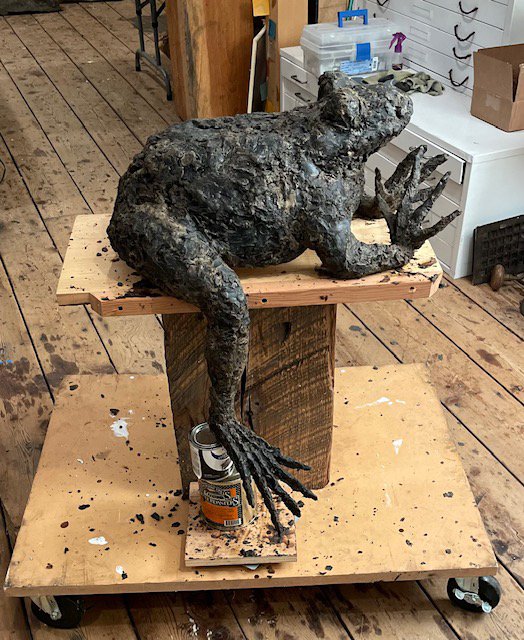I’m working in the studio on a sculpture of a frog. I talk to it while I sculpt it. I ask questions. I stroke it and I pat it. You might say I have fallen in love with this frog—though I’m not intending to kiss it, and definitely not desiring to meet a prince. This is not a frog of fairytales, but the frog who is the subject of a haiku by Matsuo Basho, Japan’s most influential 17th century haiku master.
Haiku was originally a seventeen-syllable introductory verse to a longer series of linked poems. Then in the middle of the 15th century, people began to write these short poems as a separate form. They sent them to each other, shared them. They were often playful. Basho, a maverick, was keen to use this form of poetry to express something more serious. For almost all of his life he explored the writing of haiku. Haiku became an evocation of an experience, of a moment. As an art form, it aligned with the development of Zen Buddhism in Japan, and became an instantaneous presentation of the whole without intellectual commentary.
How much could be expressed in few words? How to express an emotion like loneliness without using the word?
In 2001, when I first visited this rundown farm with its old apple orchard, I was awed by its large pond. Years earlier I had lived in Japan and been influenced by the Zen poets and traditional Japanese arts. This pond reminded me of one of Basho’s haiku and I named the farm Old Frog Pond. There are at least a hundred translations of the poem—some quite strange—but literarily it is:
Furu ike ya/ old pond (‘ya’ is a word of emphasis but without specific meaning)
Kawazu tobikomu/ frog jumps
Mizu no oto/water’s sound
In a traditional haiku, the first line often sets the scene. In this poem, we are introduced to the view of the old pond. This ageless pond might make us think about the beauty of the moon’s reflection in water, or how an old willow’s branches coax ripples on its surface. The pond may hold in its depth old carp, ancient beings.
In the second line, our gaze narrows as we see a frog. In traditional haiku writing, “Frog” was considered a season word to indicate spring. In Basho’s poem this little frog appears, a small creature, perhaps just coming out of the mud on an early spring day. Our mind holds the fragility of the frog within the expansive pond. We hold the singular among the universal.
Then, all of sudden, we are woken from our musings with a ‘splash’—the sound caused by the frog’s jump breaking the surface of the water.
Suddenly, everything disappears—our thoughts about this old pond, about the frog, the season, the setting. Only the sound exists. We are no longer thinking or making up a story. No frog and princess here. For a moment we even forget ourselves—just splash!
What does it take to be absorbed in the moment? Why is this significant?
How do we absorb ourselves in an experience? How do we have an experience?
Who is this ‘we’ that experiences?
Basho trained for several years as a Zen monk. He continued to wear the robes of a monk as his daily garb. His writing of haiku was the practice of a Zen art. His language was always simple yet conveyed the complexity of our heart/mind. In Japanese the character for kokoro, carries the meaning of ‘heart’ and ‘mind’, unlike in English where these two words are distinct.
Working on sculpture is different from writing. I form the muscles of the leg with melted wax. I press and shape the thick and sinuous body parts. I carve into hard wax the lines of the nail ridges on its webbed feet. Wax sticks to my finger tips and palms, and hardened wax packs behind my nails. When I work on the frog, I touch only frog. When I gaze at the frog, I see only frog. This frog does not jump. It is sitting. Contemplative you might say. Prayerful even. There is no splash.
A concrete pillar stands in the water between the lower pond and the small stone bridge before the pond water flows into the vast Delaney wetlands. It’s been calling for a sculpture since I moved here. Once this frog is cast into bronze, it will live on the post and gaze east towards the rising sun. Its feet will dangle and tease the water.
While working on the sculpture, I wondered if the frog should be carrying anything on its back or holding anything in its hands. But the frog was adamant. I’m just a frog. I’m a frog that is completely myself. Not going anywhere, not doing anything. Maybe that’s why I love it. Maybe that’s what love is—not needing something or someone or ourselves to be any more than just what and who we are. Not needing to do anything, only experiencing this moment fully.
Next spring I hope you will come to see this Frog in its new home.
May we all find the stillness and wakefulness of Basho’s Frog in the New Year!






